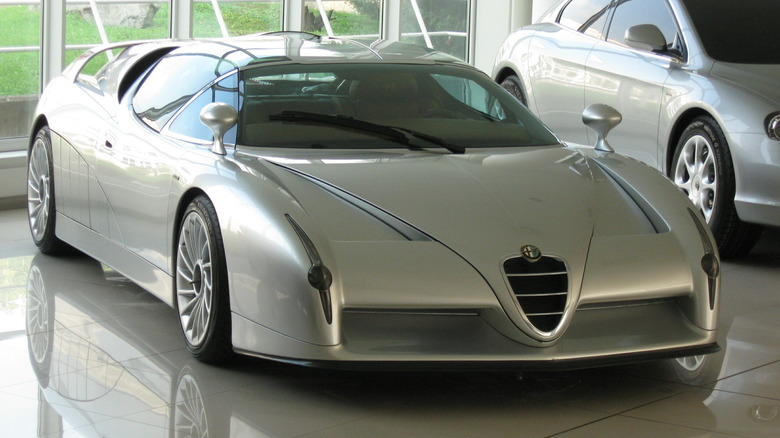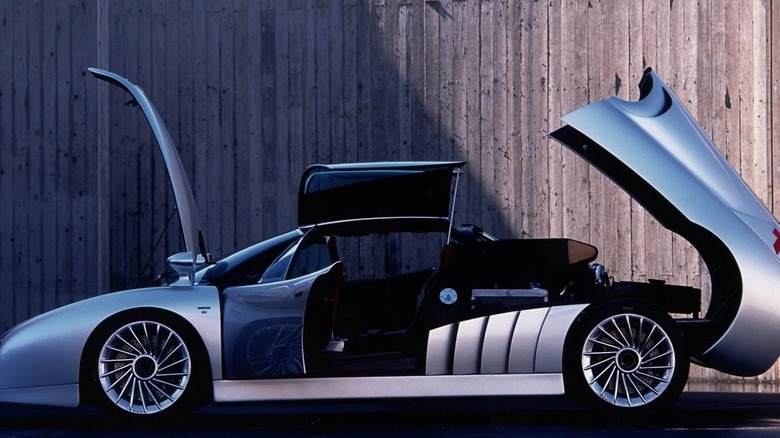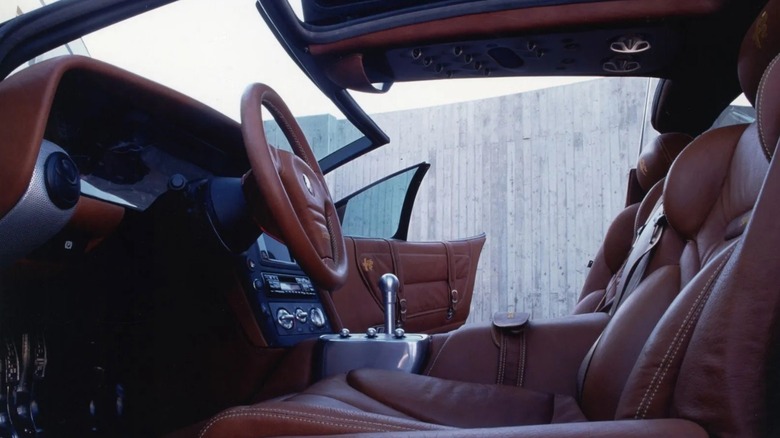The Forgotten Alfa Romeo Concept That Still Looks Sharp Today
Alfa Romeo has a penchant for building race cars and, every so often, actually racing them. It won at Le Mans in 1931 (a first for Italy), the first two Formula 1 Championships in 1950 and 1951, and then promptly "retired" undefeated in order to focus on re-launching the brand after World War II.
After popping back into racing in the '60s, it won two World Championships in 1975 and 1977, and achieved great success in the German Touring Car and Italian Superturismo series throughout the '90s. Today, Alfa Romeo will again bow out of Formula One racing at the end of 2023. Equally impressive is the fact that the company built engines for the big boys of auto racing, such as Osella, McLaren, Brabham, and March — Alfa Romeo won twice as an engine supplier.
Unlike its Italian brethren (Lamborghini, Ferrari, etc.), Alfa Romeo has never been keen to put a high-end supercar into production. That hasn't stopped Alfa Romeo from dropping the occasional prototype from time to time to drive gearheads wild. One such example occurred at the 1997 Geneva Motor Show when it debuted the Alfa Romeo Scighera, designed by none other than Italdesign. As its name clearly states, Italdesign is the famous Italian design, engineering, and prototyping firm (now part of Audi) that's played a pivotal role in creating some of the world's most iconic cars over the last 50 years.
Alfa Romeo Scighera: mist-ically fast
The Scighera, pronounced "She-geer-ah," translates to "mist" in the Italian dialect of Milanese. When you look at the sleek design, one can almost see it gliding through the mist as it floats across dew-soaked blacktop. With the F1-inspired hood raised, the hinged rear trunk (basically the whole back side of the car) pops, and the gull-wing windows — yes, windows, not doors — flapped open, it certainly gives off a "mystical" aura.
Alfa's success on the track may have inspired this prototype, but it was based on its 164 four-door V6 sedans. Despite having an entire aluminum body and aluminum carbon-fiber-reinforced polymer composite frame, according to Supercars.net, it still managed to weigh 3,200 pounds.
The She-Ra, sorry... Scighera was powered by Alfa Romeo's 3.0 L (180.6 cubic inches) twin-turbo V6 engine. At 400 horsepower and 327 foot-pounds of torque (per Supercars.net), it went from 0 to 62 in 3.8 seconds, and had a top speed of 186 miles per hour (via Concept Carz). Its permanent four-wheel drive was inspired by the Alfa's 155, another V6 compact sedan, which was also a race car.
Leather and luxury everywhere
Some of the more intriguing features included the ahead-of-its-time "clown-eyed" slit headlights, similar to what we're seeing on new cars like the Rivian R1T today. The Formula One-inspired spoiler front "hood" (remember, the engine is in the back where the trunk typically is) is swept back from the car grille on the front end. The "trunk" (where the engine was located) opened in one piece, but came with two different options. One opened just enough to put fuel in the car, while the other allowed full access to the engine. It even had a window so you could take a peek at the power plant.
The passenger windows operated ala gull-wing doors, opening upwards like the majestic wings of a mystical bird. They could even be taken out to create an open Targa concept (via Italdesign). The inside looked, quite literally, like a cow had exploded. It was bathed in Connolly leather, the same found in many high-end cars at the time. Seats, steering wheel, roof, dashboard, doors, middle console — if they could put leather on it, they did.
If you're a video gamer, you might recall seeing it pop up as a drivable car called the "Italdesign Scighera" in the PC version of "Need for Speed III: Hot Pursuit."
Even though Italdesign wanted to make this a limited production vehicle and a race car, neither ended up happening. Sadly, the video game version is the only way you can drive (albeit virtually) this incredible piece of Alfa Romeo machinery.


